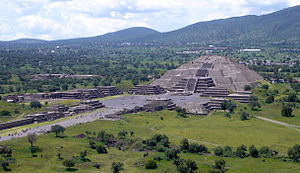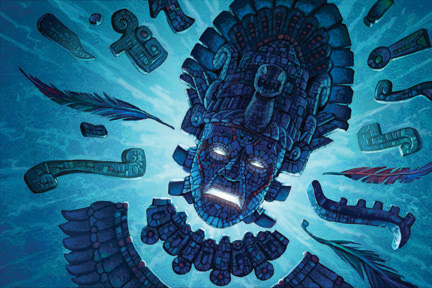 Image via Wikipedia
Image via Wikipedia
 Teotihuacan arose as a new religious center in the Mexican Highland, around the time of Christ. Although its incipient period (the first two centuries B.C.) is poorly understood, archaeological data show that the next two centuries (Tzacualli to Miccaotli phases; A.D. 1-200) were characterized by monumental construction, during which Teotihuacan quickly became the largest and most populous urban center in the New World. By this time, the city already appears to have expanded to approximately 20 square km, with about 60,000 to 80,000 inhabitants (Millon 1981:221). The development of the city seems to have involved inter-site population movements, exploitation of natural resources, an increase in agricultural production, technological inventions, establishment of trading systems and other kinds of socio-political organizations, and attractive belief systems. By the fourth century, unmistakable influences of Teotihuacan were felt throughout most parts of Mesoamerica.
Teotihuacan arose as a new religious center in the Mexican Highland, around the time of Christ. Although its incipient period (the first two centuries B.C.) is poorly understood, archaeological data show that the next two centuries (Tzacualli to Miccaotli phases; A.D. 1-200) were characterized by monumental construction, during which Teotihuacan quickly became the largest and most populous urban center in the New World. By this time, the city already appears to have expanded to approximately 20 square km, with about 60,000 to 80,000 inhabitants (Millon 1981:221). The development of the city seems to have involved inter-site population movements, exploitation of natural resources, an increase in agricultural production, technological inventions, establishment of trading systems and other kinds of socio-political organizations, and attractive belief systems. By the fourth century, unmistakable influences of Teotihuacan were felt throughout most parts of Mesoamerica.
The city seems to have functioned for centuries as a well-developed urban center until its rather sudden collapse, possibly in the seventh century. The place was called Teotihuacan by Nahuatl speakers several centuries after the city's fall, but its original name, the language or languages spoken there, and the ethnic groups who built the city are still unknown. Two main pyramids of Teotihuacan
In order to build both the Pyramid of the Sun and the Pyramid of the Moon, there needed to be a great amount of participation by the Mayan people. This suggests that Teotihuacan was a metropolis with a stable and strongly centralized authority.
Pyramid of the Sun- This is the highest pyramid in Mesoamerica north Maya. The base of this enormous pyramid is the size of Cheops in Egypt. On the day that the sun passes the zenith, the Teotihuacanos constructed the pyramid so that it is directly in front of the monument.

Pyramid of the Moon- This pyramid is known for its beauty. It is about 116 feet high and faces south with a view of the city. In front of this pyramid is the Plaza of the Moon. This contains 12 platforms which surround about 4 acres of land. In the center of the Plaza is another platform which was used for pageantry and religious ceremonies. It was also used for the burning of basin oils.
![Reblog this post [with Zemanta]](http://img.zemanta.com/reblog_e.png?x-id=e49d03fe-73fc-449a-933c-4eeb61665df9)
No comments:
Post a Comment